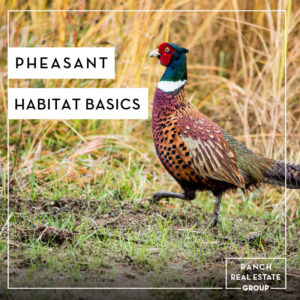Pheasant Habitat Basics
 If you are looking to purchase pheasant hunting property, or are a landowner wanting to improve your pheasant habitat it is important to have a basic understanding of the various types of habitat that pheasants use throughout the year. In spring, pheasant hens begin looking for places to nest. They select habitats that provide cover and are secure from both aerial and ground predators. Pheasant hens nest in dense grass cover that is at least 12 to 15 inches tall, which provides overhead concealment and screening from ground level.
If you are looking to purchase pheasant hunting property, or are a landowner wanting to improve your pheasant habitat it is important to have a basic understanding of the various types of habitat that pheasants use throughout the year. In spring, pheasant hens begin looking for places to nest. They select habitats that provide cover and are secure from both aerial and ground predators. Pheasant hens nest in dense grass cover that is at least 12 to 15 inches tall, which provides overhead concealment and screening from ground level.
Montana pheasant nesting habitats include fields of actively growing green wheat, stands of high-quality warm-season grass, and other areas with residual cover. After the eggs hatch, the hens immediately move the chicks to brood-rearing habitats. Quality brood-rearing habitats are areas of mostly broad-leaved flowering plants that are interspersed with bare ground that allow the chicks to move around under a canopy of vegetation, which offers protection for the chicks from overhead predators. Sainfoin is an excellent choice for wildlife food plots. It is relished by pheasants.
Another key component of quality brood habitat is an abundance of insects. Broadleaf flowering plants produce the critical insects that chicks need in their first few weeks of life. Hen pheasants and their broods spend much of the summer season in these habitats. Adequate survival cover is important year-round. This survival cover consists of grass, forb or cropland vegetation that is at least 15 inches tall, and research has proven that survival increases as vegetation gets taller. Pheasants will use woody cover such as plum thickets and windbreaks during the hottest days in summer as they provide some relief from the relentless heat of the dog days of summer.
As summer progresses into fall, pheasants shift their focus from brood rearing habitat into quality roosting, loafing and security cover. These are typically areas of dense grass, tall crop residue, growing crops or forbs. During winter, pheasants spend a small portion of each day feeding on waste grain in crop fields. Most of the day is spent loafing in adjacent taller cover, generally consisting of tall grasses, forb patches, shrub thickets, harvested crop stubble and vegetation associated with farmed playa wetlands or creek bottoms.
Pheasants need plenty of cover and food to survive Montana winters. During severe winter snowstorms, tree rows and shrub thickets become critical places for pheasants to find protection to survive the storm.
Hinge cutting trees creates cover that is thick enough for birds to seek protection in. Hinge cutting creates cover that is too thick for predators like a fox or coyote to move quickly through. It provides protection from hawks and eagles. Hinge cutting is ideal because the cover it creates is not a brush pile. It is not thick enough for raccoons or skunks to establish dens in. When hinge cutting cut the tree roughly half way through at about knee height level.
Category : Uncategorized

